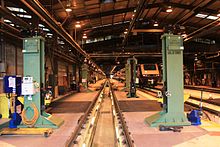St Philip's Marsh T&RSMD

An InterCity 125 inside the HST shed
|
|
| Location | |
|---|---|
| Location | Bristol, England |
| Coordinates | 51°26′48″N 2°33′57″W / 51.4468°N 2.5657°WCoordinates: 51°26′48″N 2°33′57″W / 51.4468°N 2.5657°W |
| OS grid | ST607722 |
| Characteristics | |
| Depot code(s) |
|
| Type | HST |
| History | |
| Former depot code(s) |
|
St Philip's Marsh depot is a railway depot located in the St Philip's Marsh district of Bristol, England. It was established as a steam locomotive shed in 1910 but this facility closed in the 1960s. A new diesel facility opened nearby at Marsh Junction in 1959). This has since been combined with a new shed which was opened in 1976 to maintain new Intercity 125 trainsets.
Bristol Temple Meads was the western terminus for the Great Western Railway (GWR) from London Paddington. The initial small locomotive service facilities expanded as other railway lines were opened. After the GWR absorbed the Bristol and Exeter Railway in 1876, the latter's workshops at Bristol Bath Road, which were adjacent to Temple Meads station, became the principal GWR locomotive repair and maintenance facility in the area.
In July 1910 a new shed was opened at St Philip's Marsh alongside a line which allowed through trains to avoid going through temple Meads. This new shed was mainly allocated freight locomotives including 0-6-0 Pannier Tanks which plied their trade mainly in either Bristol Docks or at Avonmouth. Bath Road, which could not expand due to the proximity of the River Avon, now serviced mostly passenger train locomotives
St Philip's Marsh shed was constructed to Churchward's standard design with two-turntables and a north light roof. The layout allowed for two additional turntables to the rear of the structure should they be required. Based on the pattern design set by Old Oak Common, the rail level was 30 feet (9.1 m) above general ground level with the shed foundations sat on concrete piles. 28 roads radiated from each 65-foot (20 m) turntable, each road having its own inspection pit. There was a standard pattern twin-ramp coaling stage, but the repair shop was only a small two-road building, due to the closeness of Bristol (Bath Road). A boiler washing plant was added in 1924, and ash shelters during World War II.
...
Wikipedia
